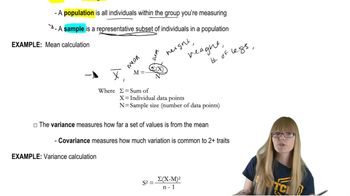The UG4 gene is expressed in stem tissue and leaf tissue of the plant Arabidopsis thaliana. To study mechanisms regulating UG4 expression, six small deletions of DNA sequence upstream of the gene-coding sequence are made. The locations of deletions and their effect on UG4 expression are shown here. Why does deletion D raise UG4 expression in leaf tissue but not in stem tissue?
Table of contents
- 1. Introduction to Genetics51m
- 2. Mendel's Laws of Inheritance3h 37m
- 3. Extensions to Mendelian Inheritance2h 41m
- 4. Genetic Mapping and Linkage2h 28m
- 5. Genetics of Bacteria and Viruses1h 21m
- 6. Chromosomal Variation1h 48m
- 7. DNA and Chromosome Structure56m
- 8. DNA Replication1h 10m
- 9. Mitosis and Meiosis1h 34m
- 10. Transcription1h 0m
- 11. Translation58m
- 12. Gene Regulation in Prokaryotes1h 19m
- 13. Gene Regulation in Eukaryotes44m
- 14. Genetic Control of Development44m
- 15. Genomes and Genomics1h 50m
- 16. Transposable Elements47m
- 17. Mutation, Repair, and Recombination1h 6m
- 18. Molecular Genetic Tools19m
- 19. Cancer Genetics29m
- 20. Quantitative Genetics1h 26m
- 21. Population Genetics50m
- 22. Evolutionary Genetics29m
13. Gene Regulation in Eukaryotes
Overview of Eukaryotic Gene Regulation
Problem 20c
Textbook Question
A muscle enzyme called ME1 is produced by transcription and translation of the ME1 gene in several muscles during mouse development, including heart muscle, in a highly regulated manner. Production of ME1 appears to be turned on and turned off at different times during development. To test the possible role of enhancers and silencers in ME1 transcription, a biologist creates a recombinant genetic system that fuses the ME1 promoter, along with DNA that is upstream of the promoter, to the bacterial lacZ (β-galactosidase) gene. The lacZ gene is chosen for the ease and simplicity of assaying production of the encoded enzyme. The diagram shows bars that indicate the extent of six deletions the biologist makes to the ME1 promoter and upstream sequences. The blue deletion labeled D is within the promoter whereas the gray bars span potential enhancer/silencer modules. The table displays the percentage of β-galactosidase activity in each deletion mutant in comparison with the recombinant gene system without any deletions.

Given the information available from deletion analysis, can you give a molecular explanation for the observation that ME1 expression appears to turn on and turn off at various times during normal mouse development?
 Verified step by step guidance
Verified step by step guidance1
Examine the diagram and table provided. The diagram shows the ME1 gene with its upstream region, promoter, and lacZ gene. The deletions (A-F) are marked as gray bars, and the table provides the percentage of lacZ activity for each deletion mutant compared to the control (no deletion).
Identify the regions affected by each deletion. Deletions A and B are in the upstream region, deletion C spans part of the upstream region, deletion D is within the promoter, and deletions E and F are further upstream.
Analyze the lacZ activity percentages. Deletions A and B show no change in activity (100%), suggesting these regions do not contain critical regulatory elements. Deletion C reduces activity to 4%, indicating the presence of an enhancer in this region. Deletion D reduces activity to <1%, showing the promoter is essential for transcription. Deletion E increases activity to 170%, suggesting the removal of a silencer. Deletion F reduces activity to 5%, indicating another critical regulatory element is present.
Interpret the molecular basis for ME1 expression regulation. Enhancers and silencers in the upstream region modulate transcription levels. The enhancer (affected by deletion C) likely increases transcription during specific developmental stages, while the silencer (affected by deletion E) suppresses transcription at other times. The promoter (affected by deletion D) is necessary for initiating transcription.
Conclude that ME1 expression is regulated by a combination of enhancers, silencers, and the promoter. These elements work together to turn ME1 transcription on and off during mouse development, allowing precise control of enzyme production in different muscles and developmental stages.
 Verified video answer for a similar problem:
Verified video answer for a similar problem:This video solution was recommended by our tutors as helpful for the problem above
Video duration:
2mPlay a video:
Was this helpful?
Key Concepts
Here are the essential concepts you must grasp in order to answer the question correctly.
Gene Regulation
Gene regulation refers to the mechanisms that control the expression of genes, determining when and how much of a gene product is produced. This process is crucial during development, as it allows cells to respond to internal and external signals, ensuring that specific genes are activated or silenced at the right times. In the context of the ME1 gene, regulation is indicated by the varying levels of β-galactosidase activity in response to different deletions in the promoter and upstream regions.
Recommended video:
Guided course

Review of Regulation
Enhancers and Silencers
Enhancers and silencers are regulatory DNA sequences that can increase or decrease gene expression, respectively. Enhancers can be located far from the promoter and interact with it through DNA looping, while silencers inhibit transcription by binding repressor proteins. The deletion analysis in the experiment suggests that certain regions upstream of the ME1 promoter may contain enhancer or silencer elements that modulate the timing of ME1 expression during mouse development.
Recommended video:
Guided course

Eukaryotic Transcription
Transcriptional Activity Measurement
Transcriptional activity can be measured using reporter genes, such as lacZ, which encodes β-galactosidase. The activity of this enzyme can be quantified, providing a direct assessment of the transcriptional output from the ME1 promoter under various conditions. In the experiment, the percentage of β-galactosidase activity in deletion mutants compared to the control indicates how different regions of the ME1 regulatory sequence influence gene expression, shedding light on the timing of ME1 activation and repression.
Recommended video:
Guided course

Mathematical Measurements
Related Videos
Related Practice
Textbook Question
443
views


